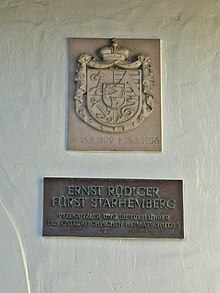Ernst Rüdiger Starhemberg
Prince Ernst Rüdiger von Starhemberg | |
|---|---|
Engelbert Dollfuß | |
| Succeeded by | Office abolished |
| Minister of the Interior | |
| In office 30 September 1930 – 4 December 1930 | |
| Chancellor | Carl Vaugoin |
| Preceded by | Vinzenz Schumy |
| Succeeded by | Franz Winkler |
| Personal details | |
| Born | 10 May 1899 Austro-Hungary |
| Died | 15 March 1956 (aged 56) Schruns, Vorarlberg, Austria |
| Political party | Heimatblock (1921–1933) Fatherland Front (1933–1938) |
| Spouses | Countess Marie Elisabeth von Salm-Reifferscheid-Raitz
(m. 1928; ann. 1937) |
| Children | 1 |
| Relatives | Starhemberg family |
| Part of a series on |
| Conservatism in Austria |
|---|
 |

Prince Ernst Rüdiger Camillo von Starhemberg, often known simply as Prince Starhemberg, (10 May 1899 – 15 March 1956) was an Austrian
Starhemberg was a leader of the
Starhemberg lived in exile in Switzerland and served with the western Allies in the British and Free French Air Forces for a short period at the beginning of World War II, but became disenchanted with them when they entered into an alliance with Joseph Stalin's Soviet Union, which he viewed as equally evil as the Nazis. He left for Argentina where he spent the next thirteen years in exile. He died during an extended visit to Austria in 1956.
He was the 1,163rd Knight of the Order of the Golden Fleece, Austrian Order.
Biography
Born in
Seeking election to the Bundesrat, the representation of Austrian states (Länder) at age 21, Starhemberg became a proponent of
When conservative
With these positions, Starhemberg was in effect the second most powerful man in Austria. During this period, the regime fought to keep Austria an independent state by support from France, the United Kingdom and Fascist Italy and through crackdowns on Austrian Nazis and others favoring a union with Germany. The idea of union with Germany had been popular among Socialists as well as Conservatives, although the Treaty of Saint-Germain-en-Laye (1919) which Austria signed at the end of World War I forbade it.
In 1936, Starhemberg's disagreements with Schuschnigg, who, inspired by the appeasement policies of the western democracies, wanted to improve relations with Nazi Germany rather than risk invasion by a far stronger Wehrmacht and face possible desertion by Hitler's new-found ally, Mussolini. In March 1936, Starhemberg was forced to relinquish his position as Federal leader of the Fatherland's Front, which was dissolved (as was the Heimwehr) and on 14 May that year he was ousted from the government.
After the
Starhemberg died in Schruns, Vorarlberg, during an extended visit to Austria in 1956. He was staying at a spa in Schruns. During a walk, he was photographed against his will by Georg Auer, a journalist who worked at a communist newspaper. In response, Starhemberg became enraged and attacked Auer with his walking stick.[5] However, he suddenly suffered a cardiac arrest and died.[6]
Marriages
Starhemberg married two times:
- Marie-Elisabeth Altgräfin zu Salm-Reifferscheidt-Raitz (Donaueschingen, 1 March 1908 – Gmunden, 10 April 1984), married in Vienna on 9 September 1928, annulled on 27 November 1937. She had no children but adopted, in 1973 as her heir, a cousin, Maria Elisabeth (Marielies) Leopoldine Hippolyta, Altgräfin zu Salm-Reiferscheidt-Raitz (born 1931).
- Santiago, 20 January 1949), Austrian-Jewish stage and film actress, married in Vienna on 2 December 1937. They had one child, who was born prior to their marriage, Heinrich Rüdiger Gregor (1934-1997), known from 1937 as Heinrich Rüdiger Karl Georg Franciscus Graf von Starhemberg, later, upon the death of his father, became 8th Fürst von Starhemberg. He died unmarried and without issue so his title was inherited by his cousin Georg Adam (b. 1961) who is the current Prince and Head of the family.[citation needed]
Notes
- ^ Der Vizekanzler – Führer der Vaterländischen Front. In Neue Freie Presse, 31 July 1934 (german).
- ^ Dr. v. Schuschnigg über die Führung der V. F. In Neue Freie Presse, 16 May 1936 (german).
- ^ "Austria: Death for Freedom". Time. 6 August 1934. Archived from the original on 28 June 2011. Retrieved 27 January 2011.
- ^ "The Neutralization of Fritz Mandl: Notes on Wartime Journalism, the Arms Trade, and Anglo-American Rivalry in Argentina during World War II*". read.dukeupress.edu. Retrieved 20 March 2024.
- ^ Scheidl, 22 12 2011 um 11:55 von Hans Werner (14 December 2011). "Widersprüchlicher Heimwehrführer". Die Presse (in German). Retrieved 26 November 2023.
{{cite web}}: CS1 maint: numeric names: authors list (link) - ISBN 978-3-7065-4331-6, p. 416.
